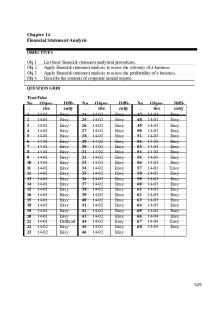X10 Financial Statement Analysis DOC

| Title | X10 Financial Statement Analysis |
|---|---|
| Author | Min Min |
| Pages | 5 |
| File Size | 433 KB |
| File Type | DOC |
| Total Downloads | 447 |
| Total Views | 650 |
Summary
Financial Statement Analysis MODULE 10 small. Which type of numbers would be most meaningful for statement analysis? A. Absolute numbers would be most meaningful for both the large and small firm. FINANCIAL STATEMENT ANALYSIS B. Absolute numbers would be most meaningful in the large firm; relative n...
Description
Financial Statement Analysis MODULE 10 FINANCIAL STATEMENT ANALYSIS THEORIES: 6. Management is a user of financial analysis. Which of the following comments does not represent a fair statement as to the management perspective? A. Management is always interested in maximum profitability. B. Management is interested in the view of investors. C. Management is interested in the financial structure of the entity. D. Management is interested in the asset structure of the entity. Limitations 1. A limitation in calculating ratios in financial statement analysis is that A. it requires a calculator. B. no one other than the management would be interested in them. C. some account balances may reflect atypical data at year end. D. they seldom identify problem areas in a company. 2. Which of the following is not a limitation of financial statement analysis? A. The cost basis. C. The diversification of firms. B. The use of estimates. D. The availability of information. 5. Which of the following does not represent a problem with financial analysis? A. Financial statement analysis is an art; it requires judgment decisions on the part of the analyst. B. Financial analysis can be used to detect apparent liquidity problems. C. There are as many ratios for financial analysis as there are pairs of figures. D. Some industry ratio formulas vary from source to source. 77. The use of alternative accounting methods: A. is not a problem in ratio analysis because the footnotes disclose the method used. B. may be a problem in ratio analysis even if disclosed. C. is not a problem in ratio analysis since eventually all methods will lead to the same end. D. is only a problem in ratio analysis with respect to inventory. Industry Analysis 3. Suppose you are comparing two firms in the steel industry. One firm is large and the other is small. Which type of numbers would be most meaningful for statement analysis? A. Absolute numbers would be most meaningful for both the large and small firm. B. Absolute numbers would be most meaningful in the large firm; relative numbers would be most meaningful in the small firm. C. Relative numbers would be most meaningful for the large firm; absolute numbers would be most meaningful for the small firm. D. Relative numbers would be most meaningful for both the large and small firm, especially for interfirm comparisons. 4. Which of these statements is false? A. Many companies will not clearly fit into any one industry. B. A financial service uses its best judgment as to which industry the firm best fits. C. The analysis of an entity's financial statements can be more meaningful if the results are compared with industry averages and with results of competitors. D. A company comparison should not be made with industry averages if the company does not clearly fit into any one industry. Common-sized financial statements 9. Which of the following generally is the most useful in analyzing companies of different sizes? A. comparative statements C. price-level accounting B. common-sized financial statements D. profitability index 12. Statements in which all items are expressed only in relative terms (percentages of a base) are termed: A. Vertical statements C. Funds Statements B. Horizontal Statements D. Common-Size Statements 10. The percent of property, plant and equipment to total assets is an example of: A. vertical analysis C. profitability analysis B. solvency analysis D. horizontal analysis 15. Vertical analysis is a technique that expresses each item in a financial statement A. in pesos and centavos. B. as a percent of the item in the previous year. C. as a percent of a base amount. D. starting with the highest value down to the lowest value. 17. In performing a vertical analysis, the base for prepaid expenses is 567...
Similar Free PDFs

X10 Financial Statement Analysis
- 5 Pages

Ch14 Financial Statement Analysis
- 52 Pages

Financial Statement Analysis DIgi
- 13 Pages

Ch19 Financial Statement Analysis
- 31 Pages

Financial Statement Analysis
- 26 Pages

Financial Statement Analysis QUIZ
- 111 Pages

Financial Statement Analysis MCQ
- 16 Pages

Financial Statement Analysis CFA
- 74 Pages

Telstra Financial Statement Analysis
- 18 Pages

Financial Statement Analysis MCQ
- 43 Pages

Financial-Statement- -Analysis
- 18 Pages
Popular Institutions
- Tinajero National High School - Annex
- Politeknik Caltex Riau
- Yokohama City University
- SGT University
- University of Al-Qadisiyah
- Divine Word College of Vigan
- Techniek College Rotterdam
- Universidade de Santiago
- Universiti Teknologi MARA Cawangan Johor Kampus Pasir Gudang
- Poltekkes Kemenkes Yogyakarta
- Baguio City National High School
- Colegio san marcos
- preparatoria uno
- Centro de Bachillerato Tecnológico Industrial y de Servicios No. 107
- Dalian Maritime University
- Quang Trung Secondary School
- Colegio Tecnológico en Informática
- Corporación Regional de Educación Superior
- Grupo CEDVA
- Dar Al Uloom University
- Centro de Estudios Preuniversitarios de la Universidad Nacional de Ingeniería
- 上智大学
- Aakash International School, Nuna Majara
- San Felipe Neri Catholic School
- Kang Chiao International School - New Taipei City
- Misamis Occidental National High School
- Institución Educativa Escuela Normal Juan Ladrilleros
- Kolehiyo ng Pantukan
- Batanes State College
- Instituto Continental
- Sekolah Menengah Kejuruan Kesehatan Kaltara (Tarakan)
- Colegio de La Inmaculada Concepcion - Cebu




